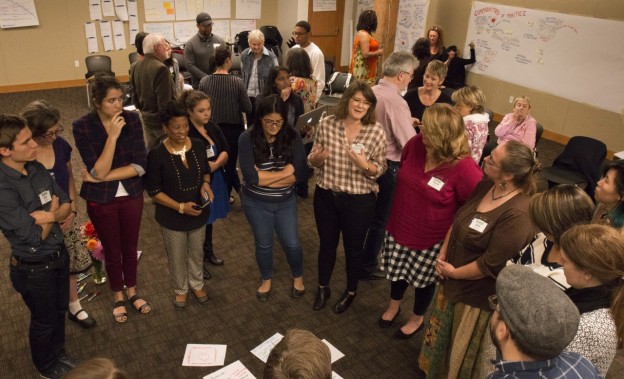Canadian start-up Discourse Media has won awards, acclaim, and scholarly attention for its innovative style of collaborative solutions journalism. But three years ago, when co-founder Erin Millar first started approaching prospective collaboration partners, Millar says the idea wasn’t exactly met with high-fives and applause.
 “It was like I was speaking Greek,” she joked. “Getting across some of those competitive barriers is really tricky.”
“It was like I was speaking Greek,” she joked. “Getting across some of those competitive barriers is really tricky.”
These days, Discourse Media’s collaborative approach is finding a more receptive audience in Canada, Millar says — and increasingly it’s no anomaly. From San Francisco to Brazil to Europe, collaboration between news organizations appears to be catching on — a trend highlighted this spring by the Panama Papers investigation, a year-long collaboration led by the International Consortium of Investigative Journalists to expose global tax evasion and money laundering.
“Historically, when you were trying to break a story, the worst thing in the world would be to reveal it to your competitors,” said Andrew DeVigal, chair in journalism innovation and civic engagement at University of Oregon’s Agora Journalism Center, which will launch a collaborative project called “One Issue, Many Perspectives” this summer. “But collaboration has become more of a positive thing. It’s a way to expand your limited reporting resources so that you create a better product in the end.”
Amid shrinking newsroom budgets — and in a digital media environment that’s less amenable to “exclusives” — DeVigal says collaborative journalism has emerged as a way to pool resources, expertise, and audience reach for deep-dive investigative and explanatory journalism. Notable examples include:
- A Pulitzer-Prize winning investigation of violence and neglect at Florida’s mental hospitals by the Tampa Bay Times and Sarasota Herald-Tribune
- A one-day blitz of homelessness coverage by the San Francisco Chronicle, Mother Jones, the San Francisco Examiner, and other Bay Area partners
- A storytelling collaboration on mental health challenges in developing countries, led by the Global Reporting Centre
- A beta platform for collaborative environmental reporting in Brazil
- A network of data-driven storytellers at six for-profit news organizations in Europe
To help build knowledge around collaboration’s opportunities, challenges, and best practices, MediaShift is launching a special series on collaborative journalism that will run throughout the summer.
Series Stories:
> 3 Tips from KUT and Austin Monitor On Making Media Collaboration Work, by Michael Kanin and Matt Largey
> Public Media Stations Share Lessons from Regional Collaborations, by Ben DeJarnette
> Built on Collaboration, Discourse Media Closes in on Profit, by Ben DeJarnette
> Journalists and Academics Working Together? At a Canadian Nonprofit, It’s Paying Off, by Ben DeJarnette
> 3 Ways Public Media are Collaborating on Election Coverage in California, by Ben DeJarnette
> 3 Tips from KUT and Austin Monitor On Making Media Collaboration Work, by Michael Kanin
We also want to hear from you. Has your organization started to experiment with collaboration? Have those efforts yielded resounding triumphs? Insightful failures? If you have a story to tell about your experience with collaborative journalism, drop me a line on Twitter or email a pitch to our managing editor Courtney Cowgill.
And in the spirit of collaboration, let’s do this together.
Ben DeJarnette is the associate editor at MediaShift. He is also a freelance contributor for Pacific Standard, InvestigateWest, Men’s Journal, Runner’s World, Oregon Quarterly and others. He’s on Twitter @BenDJduck.

